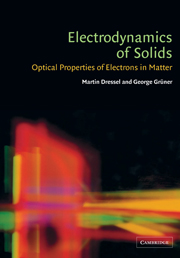PART ONE - CONCEPTS AND PROPERTIES
Published online by Cambridge University Press: 20 May 2010
Summary
Introductory remarks
In this part we develop the formalisms which describe the interaction of light (and sometimes also of a test charge) with the electronic states of solids. We follow usual conventions, and the transverse and longitudinal responses are treated hand in hand. Throughout the book we use simplifying assumptions: we treat only homogeneous media, also with cubic symmetry, and assume that linear response theory is valid. In discussing various models of the electron states we limit ourselves to local response theory – except in the case of metals where non-local effects are also introduced. Only simple metals and semiconductors are treated; and we offer the simple description of (weak coupling) broken symmetry – superconducting and density wave – states, all more or less finished chapters of condensed matter physics. Current topics of the electrodynamics of the electron states of solids are treated together with the experimental state of affairs in Part 3. We make extensive use of computer generated figures to visualize the results.
After some necessary preliminaries on the propagation and scattering of electromagnetic radiation, we define the optical constants, including those which are utilized at the low energy end of the electrodynamic spectrum, and summarize the so-called Kramers–Kronig relations together with the sum rules. The response to transverse and longitudinal fields is described in terms of correlation and response functions. These are then utilized under simplified assumptions such as the Drude model for metals or simple band-to-band transitions in the case of semiconductors.
Information
- Type
- Chapter
- Information
- Electrodynamics of SolidsOptical Properties of Electrons in Matter, pp. 7 - 8Publisher: Cambridge University PressPrint publication year: 2002
